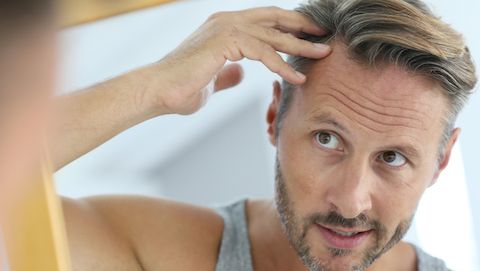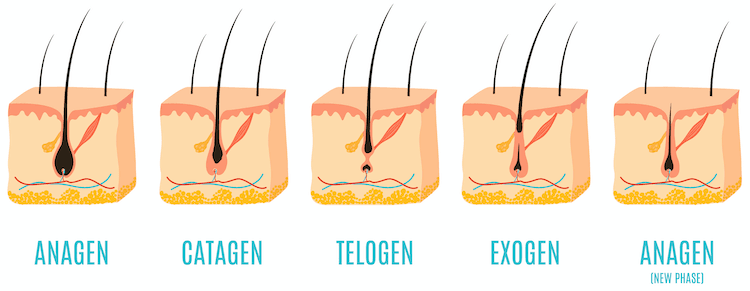
Alopecia, the medical term for hair loss, is a common concern that affects the majority of men and up to 50% of women in their lifetime. 55% of men have noticeable hair loss by just 40 years of age. It is likely that you, male or female, no matter your race or background, will experience some form of hair loss, at some point in your life. It may be temporary (caused by stress or pregnancy for example), or it may be permanent, such as androgenetic alopecia.
Our hair is an important part of our emotional wellbeing, enhancing our confidence, contributing to our well-being and influencing our social connections…hence the popular saying, “having a bad hair day” when everything seems to be going wrong!
So what is it that causes alopecia and what can be done about it? If you suffer from hair loss or alopecia, answer these 3 questions to discover the best treatment option for you.
Understanding How Hair Grows
To differentiate between normal shedding and alopecia, it helps to understand the hair growth cycles. Many people assume that hair continues to grow for life. In fact, hair goes through four different stages in a cycle; the hair grows, it transitions, it rests, then it sheds, with the full cycle taking between two to seven years. Hair follicles are programmed to perform between 25 and 30 cycles in a lifetime. When a person suffers from androgenetic alopecia, the cycles accelerate and are exhausted sooner.
Hair is composed of two structures; the hair shaft and the follicle. The shaft, or strand, is the visible hair you see, made up of a hard protein called keratin. The follicle is a narrow tube in the skin, through which the hair strand grows. Hair shafts are actually dead, that’s why it’s painless to cut our hair. It’s important to look after the health of our scalp and follicles as well as the actual hair itself.
The Hair Growth Cycle

Luckily, follicles are never all in the same phase of the cycle at the same time, otherwise we would shed all our hair at once! Each phase of the hair growth cycle is as follows:
Anagen – Growth: the active growth phase of new hair formation. Cells at the base of the hair follicle divide rapidly, resulting in new hair growth. Hair on your scalp stays in anagen for 2-5 years, the length of the anagen phase determines the maximum length of the hair. People who can grow their hair very long have a longer anagen phase. Most of your hair follicles (80-90%) are in anagen at any given time. Factors that influence the length of the anagen phase include health, nutrition, genetics and age.
Catagen – Transition: after anagen, hair goes into a short transitional phase where growth stops and the outer root sheath shrinks away from the follicle wall and attaches to the root of the hair shaft. This phase lasts for 2-3 weeks and about 3% of all hair follicles are in this phase at any given time. The hair is referred to as club hair.
Telogen – Rest: after catagen, hair goes into telogen or the resting phase that lasts for about 100 days for scalp hair. The club hair rests whilst a new hair forms beneath it. Around 10-15% of hair follicles are in telogen at any one time.
Exogen – Shedding: following telogen, exogen or shedding is the last part of the hair growth cycle. During exogen, the club hair is pushed out by the newly growing hair beneath it, it detaches and falls out. It is normal to lose up to 100 hairs per day due to the constant growth, transition, rest and shedding cycle.
After shedding, the follicle returns to the growth phase and the cycle repeats.
There is an important distinction to make between shedding, which occurs as part of the normal cycle of hair growth, and hair loss. It is quite normal to shed 50-100 hairs a day, through brushing or washing your hair, or as the old hair is pushed out by new hair growth. As we age, some of the hair follicles stop producing new hair, or the anagen phase gets progressively shorter and the hair is shed at a faster rate.
Hair loss occurs through other factors that either effect the health of the hair follicle, or disrupt the normal cycle of hair growth. Some of these effects are reversible and normal hair growth returns once the trigger is removed. Other factors can’t be reversed without medical help.
Different Types of Hair Loss or Alopecia
Androgenetic Alopecia
The most common reason for hair loss and baldness is genetics. Referred to as androgenetic alopecia, this type of hair loss in men occurs in a distinct pattern that progresses over many months or years. The pattern starts with a receding hairline and thinning of the crown, leading to baldness on top and in many cases, only hair around the side and back of the head remains. The hair loss is so predictable that a classification scale, referred to as the Norwood Scale, was developed.
In women, androgenetic alopecia doesn’t tend to form a pattern, but rather, is distributed across the entire scalp as diffuse hair loss.
Telogen Effluvium
Leading Trichologists (hair specialists) are seeing an increase in the frequency of reactive hair loss, also known as telogen effluvium. Stress, changes in diet, illness, and pregnancy can have a significant effect on the human body. When the body is under “stress” large numbers of follicles can prematurely enter telogen (the resting phase) and stop growing. By shutting down or conserving non-essential functions, like growing hair, the body can concentrate on other, more essential functions. This phenomenon involves shedding larger amounts of hair and appears as diffuse thinning all over the scalp. Typically, telogen effluvium is reversible and those affected will regain normal hair growth after several months, once the trigger (eg stress) has ceased.
Anagen Effluvium
The sudden or rapid loss of hair in anagen is referred to as anagen effluvium, normally as a result of serious medication, poisoning or treatment such as chemotherapy. It can appear as diffuse or total loss of hair. It is generally reversible, with follicles able to regenerate after the trigger is removed. Anyone with unexplained or sudden hair loss should seek medical attention immediately.
Alopecia Areata
Patches of hair loss on the scalp, face or body are a type of hair loss indicated as alopecia areata. Alopecia areata is an autoimmune disease where the body attacks the hair follicles. In some cases, the condition progresses to total hair loss on the scalp (alopecia totalis) or complete hair loss on the body (alopecia universalis).
Traction Alopecia
Extended tight hairstyles such as dreadlocks, cornrows or very tight ponytails or braids can lead to traction alopecia. Ongoing or repetitive hairstyling of this kind can lead to permanent hair loss.
How can Gro help?
For a correct diagnosis for your hair loss, the first step is to book a consultation with a Gro hair growth specialist. During your private consultation, you will receive personalised information for your hair loss and the opportunity to discuss various treatment options, customised to your particular condition.
Simply click on one of the buttons below to book a consultation or ask a question. Alternatively, you can call us on 1300 787 563.













